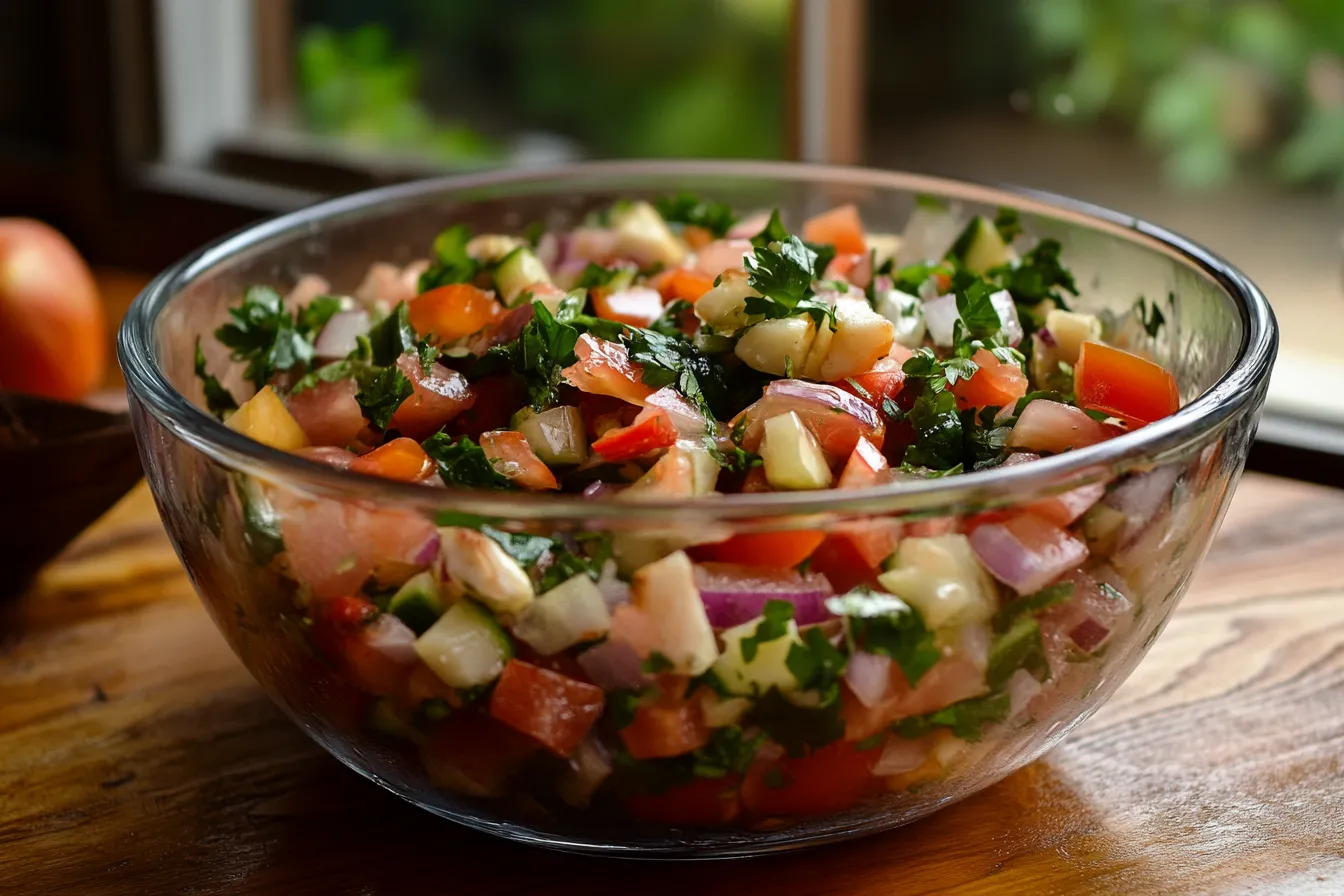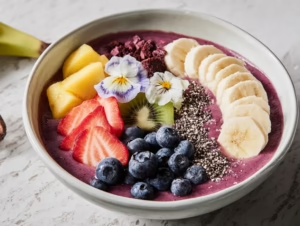Do you love the refreshing taste of a classic Greek salad? But wish to avoid the dairy? Introducing our Greek Salad Without Feta Cheese. It’s a delightful, dairy-free twist on the Mediterranean favorite.
This easy-to-prepare recipe captures all the vibrant flavors of a traditional Horiatiki. It does this without the need for feta cheese.
Crafted with fresh vegetables, a zesty dressing, and a touch of herbs, our Dairy-Free Greek Salad is perfect for summer. It’s a low-calorie, gluten-free option. Or just a way to enjoy Mediterranean flavors.
Table of Contents

Greek Salad Without Feta Cheese
Equipment
- Cutting board For chopping vegetables
- Knife For slicing ingredients
- Mixing bowl For tossing the salad
- Whisk For mixing the dressing
- Salad tongs For serving the salad
Ingrédients
- 2 cucumbers chopped
- 2 cups cherry tomatoes halved
- 1 red bell pepper sliced
- 1/2 red onion thinly sliced
- 1/2 cup kalamata olives pitted and halved
- 1/4 cup fresh parsley chopped
Dressing
- 1/4 cup olive oil
- 2 tbsp red wine vinegar
- 1 tsp Dijon mustard
- 1 tsp dried oregano
- 1/2 tsp salt
- 1/2 tsp black pepper
- 1 clove garlic minced
Instructions
Prepare the Dressing
- In a mixing bowl, whisk together olive oil, red wine vinegar, Dijon mustard, oregano, salt, black pepper, and minced garlic until well combined.
Assemble the Salad
- In a large salad bowl, add the chopped cucumbers, cherry tomatoes, red bell pepper, red onion, and kalamata olives.
Dress and Serve
- Drizzle the dressing over the salad and toss gently to combine.
- Garnish with fresh parsley and serve immediately.
Nutrition
Introduction to Greek Salad Without Feta Cheese
Discover the beauty of a Vegan Greek Salad or Meatless Greek Salad without feta cheese. This Greek-Inspired Salad brings the Mediterranean’s lively tastes to life. It lets fresh veggies and herbs be the stars.
What is Greek Salad?
Greek salad, or horiatiki salata, is a favorite in Greek food. It has tomatoes, cucumbers, bell peppers, onions, olives, and feta cheese. It’s dressed with a simple vinaigrette. Real Greek salads don’t have lettuce, so the veggies’ strong tastes are the main event.
Why Skip the Feta?
Leaving out the feta makes this Vegan Greek Salad good for more people. It’s perfect for those who don’t eat meat or dairy. Without feta, the salad’s veggies can be the main attraction, offering a fresh and light twist on the classic.
« A memorable experience with a unique Greek salad involved vegetables cut into large chunks, crumbly feta cheese, large black olives, dried wild thyme, and greenish-colored olive oil. »
This quote shows how key quality ingredients and old ways are in a great Greek salad. It captures the heart of Greek cooking.
Key Ingredients for Our Salad
To make the perfect Mediterranean Salad, we use the freshest ingredients. Our recipe brings together vibrant colors and strong tastes. It’s a favorite in the summer.
Fresh Vegetables
The base of our Summer Salad is crisp, ripe veggies. We use juicy cherry tomatoes, crunchy English cucumbers, and colorful bell peppers. Thinly sliced red onion and Kalamata olives add a rich flavor.
Olive Oil and Vinegar
The dressing for our Mediterranean Salad is simple yet tasty. We mix high-quality olive oil with tangy red wine vinegar. A squeeze of fresh lemon juice brightens it. A bit of Dijon mustard helps mix the dressing.
Herbs and Spices
We add fragrant oregano, dill, and mint leaves for the Mediterranean taste. These herbs make the Healthy Salad bold and aromatic.
« The key to a delicious Mediterranean Salad is using the freshest, highest-quality ingredients you can find. » – Chef Maria Loi
Step-by-Step Preparation
Making a tasty Greek Salad Without Feta Cheese or a yummy Vegetarian Greek Salad is easy. You can enjoy a healthy and refreshing meal. Here’s how to make this colorful salad.
Chopping the Vegetables
Begin by chopping the veggies carefully. Cut the tomatoes and cucumbers into big pieces. Slice the red onion and bell pepper thinly. This adds crunch and color to the salad.
Mixing the Dressing
Next, mix the dressing ingredients in a small jar or bowl. Use extra-virgin olive oil, lemon juice, red wine vinegar, garlic, oregano, sea salt, and black pepper. Whisk until it’s smooth and well mixed.
Put the chopped veggies in a bowl. Pour the dressing over them. Toss gently until everything is coated. Chill for 30 minutes to let the flavors mix.
The secret to a great Greek Salad Without Feta Cheese or Vegetarian Greek Salad is balance. Use crisp veggies and a tangy dressing. Follow these steps to make a salad that looks good and tastes amazing.
Flavor Enhancements
Want to make your Greek salad even better? Try adding capers or roasted red peppers. They add a salty and sweet taste. You can also add grilled tofu or roasted chickpeas for extra protein.
Additional Toppings
- Capers: Lend a delightful salty and tangy flavor.
- Roasted red peppers: Provide a sweet and smoky element.
- Grilled tofu: Offers a plant-based source of protein.
- Roasted chickpeas: Add crunch and nutty undertones.
- Kalamata olives: Impart a quintessential Greek touch.
Dressing Variations
Try new dressing styles to make your Greek Salad Variation better. Dijon mustard adds a creamy touch. Honey balances the acidity. Fresh herbs like parsley or mint brighten the flavors.
For olive lovers, Kalamata olives add a real Mediterranean Salad taste.
| Ingredient | Quantity |
|---|---|
| Romaine hearts | 4 |
| Red onion | 1 small |
| Feta cheese | 1 6-ounce slab |
| Kalamata olives | 1/4 cup |
| Stuffed grape leaves (dolmas) | 8 to 10 canned or fresh |
| Heirloom tomato | 1 medium ripe |
| Kirby or Persian cucumbers | 2 to 3 small |
| Anchovy fillets | 4 or 5 oil-packed |
| Red wine vinegar | – |
| Sea salt | – |
« Using high-quality ingredients like organic greens, premium olive oil, and fresh-cracked pepper can elevate the flavors in your Greek Salad Variation. »
Nutritional Benefits
The Vegan Greek Salad you’re about to make is tasty and full of good stuff. It has few calories, with each serving (406g) having about 195 calories. This is good for those who want to lose weight or eat fewer calories.
This salad is also full of vitamins and minerals. It has lots of Vitamin C, giving you 35% of what you need every day. It also has Vitamin K (39% DV), Vitamin E, Vitamin B6, Folate, and Copper.
The salad is also high in fiber, with 5g per serving. This helps with digestion and makes you feel full. It also has potassium, which is good for your blood pressure.
The olive oil in the dressing is good for your heart. It has monounsaturated fats that help fight inflammation and lower disease risk. Without feta cheese, the salad has less saturated fat and sodium. This makes it great for diets like 2B Mindset, Whole30, or Paleo.
In short, this Vegan Greek Salad is a nutritional powerhouse. You can enjoy it without feeling guilty. It’s low in calories, full of vitamins and minerals, and has healthy fats. It’s perfect for a balanced, healthy diet.
Serving Suggestions
This Greek-Inspired Salad is great with many meals. It goes well with burgers, salmon, or other Summer Salads. It’s a perfect side dish.
Pair it with grilled meats, fish, or falafel for a healthy meal. It’s great at BBQs or summer parties. It adds to the taste of main dishes.
Ideal for Meal Prep
The Greek-Inspired Salad is perfect for meal prep. Chop veggies ahead, then add dressing just before eating. It’s a quick, healthy meal on busy days.
Enjoy it alone or with other Mediterranean dishes. This Summer Salad will please your taste buds and keep you healthy.

Storing Leftover Salad
After enjoying your Greek Salad Without Feta Cheese, you might have leftovers. To keep your healthy salad fresh, follow these easy tips.
Best Practices for Freshness
Store the salad parts in separate airtight containers. This keeps the veggies crisp and flavors fresh. When you’re ready, toss the salad with dressing.
Shelf Life Tips
- The Greek Salad Without Feta Cheese stays fresh for 3 days in the fridge.
- Storing with dressing added softens veggies and blends flavors. Many like this taste.
- Don’t add dressing to stored salad. Dress it just before eating for best taste.
- When you eat your salad, toss it and adjust the seasoning if needed.
By storing your salad right, you can enjoy it for days. Enjoy your healthy and tasty leftovers!
Common Mistakes to Avoid
Making a great Greek salad is like art. Stay away from common mistakes to make your salad better. Whether it’s a classic Greek salad or a Mediterranean salad twist, avoid these errors for the best salad.
Overwhelming Flavors
A Greek salad is all about balance. Don’t add too much dressing or herbs. Just a little olive oil, vinegar, or lemon juice is enough to enhance the veggies.
Cutting Vegetables Incorrectly
How you cut veggies is key for a real Greek salad feel. Cut tomatoes and cucumbers big, and onions thin. Don’t use waxed cucumbers without peeling them. This keeps the salad fresh and flavorful.
| Ingredient | Authentic Greek Salad Preparation |
|---|---|
| Tomatoes | Large chunks, 650-730 grams |
| Cucumbers | Large chunks, 340 grams |
| Bell Peppers | Large pieces, 255-340 grams |
| Red Onion | Thinly sliced, 85-115 grams |
| Feta Cheese | Large slices, 100-140 grams |
| Olives | Whole, a handful |
By avoiding these mistakes and sticking to traditional ways, you’ll make a Mediterranean salad that looks good and tastes amazing.
Alternative Recipes
The Greek-inspired salad without feta cheese is tasty and flexible. You can try many different versions. Add Mediterranean twists or use seasonal ingredients for unique salads.
Mediterranean-Inspired Variations
Add Mediterranean flair with artichoke hearts, sun-dried tomatoes, or grilled zucchini. For a fuller salad, add roasted beets or sweet potatoes. Try balsamic or apple cider vinegar for a richer dressing.
Seasonal Ingredients to Add
- In summer, add watermelon or peaches for a cool touch.
- In winter, roast carrots, parsnips, or butternut squash for warmth.
- Try vegan cheese or creamy mozzarella for a different taste.
The Greek-Inspired Salad is very flexible. It lets you try many Mediterranean and seasonal flavors. Be creative and make it your own!
Conclusion
This dairy-free Greek salad is a refreshing choice. It’s full of crisp veggies, tangy dressing, and herbs. It’s a great way to enjoy Mediterranean flavors.
It’s perfect for a light side dish or a main course. This salad will surely impress you.
Recap of the Recipe Highlights
This salad is quick to make and packed with nutrients. It has juicy cherry tomatoes, crunchy cucumbers, and savory olives. Plus, it has aromatic herbs.
This mix of ingredients makes a vibrant and tasty dish. It will make your taste buds happy.
Encouragement to Try the Salad
If you love Greek salad or want a healthy summer salad, try this. It has bold flavors and is dairy-free. You’ll love making and eating this Mediterranean classic.
FAQ
What are the main ingredients in a traditional Greek salad?
A traditional Greek salad, or Horiatiki, has tomatoes, cucumber, olives, and feta cheese.
Why skip the feta cheese in this recipe?
Skipping the feta cheese makes the salad dairy-free. It meets different dietary needs and tastes.
What are the essential ingredients in this Greek salad recipe without feta?
You need ripe tomatoes, cucumber, red onion, bell pepper, and Kalamata olives. The dressing has olive oil, red wine vinegar, and lemon juice. Add fresh herbs like oregano, dill, and mint.
How do you prepare the salad?
Chop tomatoes and cucumber into big chunks. Thinly slice the red onion and bell pepper. Put them in a bowl.
Make the dressing with olive oil, red wine vinegar, lemon juice, garlic, and herbs. Pour it over the salad before serving.
Can I add any additional toppings or make dressing variations?
Yes, add capers or roasted red peppers for more flavor. Try different dressings by adding Dijon mustard or honey.
How nutritious is this Greek salad without feta?
This salad is low in calories and full of vitamins A and C, potassium, and fiber. Olive oil adds healthy fats. Without feta, it’s lower in saturated fat and sodium.
What are some serving suggestions for this salad?
It goes well with grilled meats, fish, or falafel. Great as a side at BBQs or a light lunch or dinner.
How should I store leftovers?
Store salad parts in airtight containers. The salad lasts up to three days in the fridge. Toss it before eating and adjust seasoning.
What are some common mistakes to avoid when making this salad?
Don’t use too much dressing or herbs. Cut veggies right for size and avoid waxed cucumbers. Don’t mix too hard to avoid bruising.
Can I create variations of this Greek salad?
Yes, add artichoke hearts, sun-dried tomatoes, or grilled zucchini. For winter, use roasted root veggies. Try different vinegars or add fruits like watermelon or peaches.



